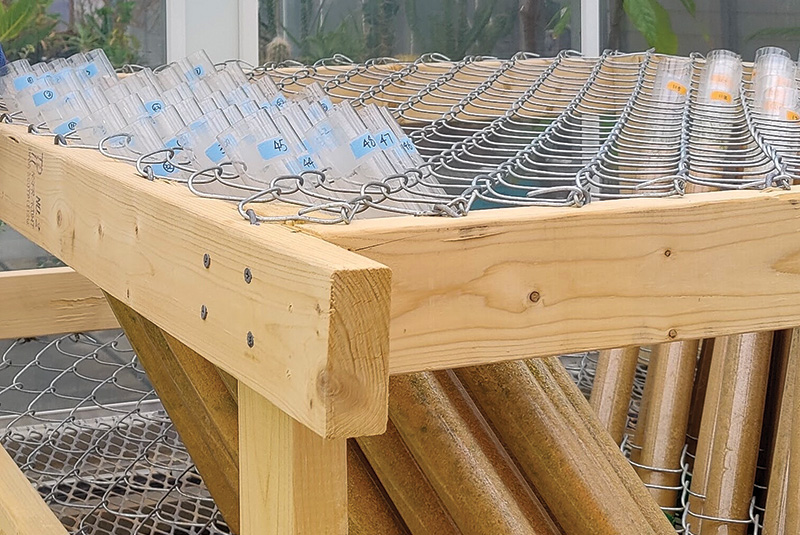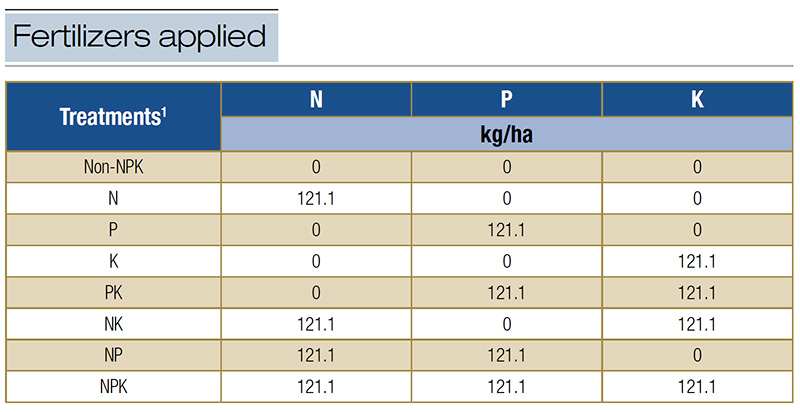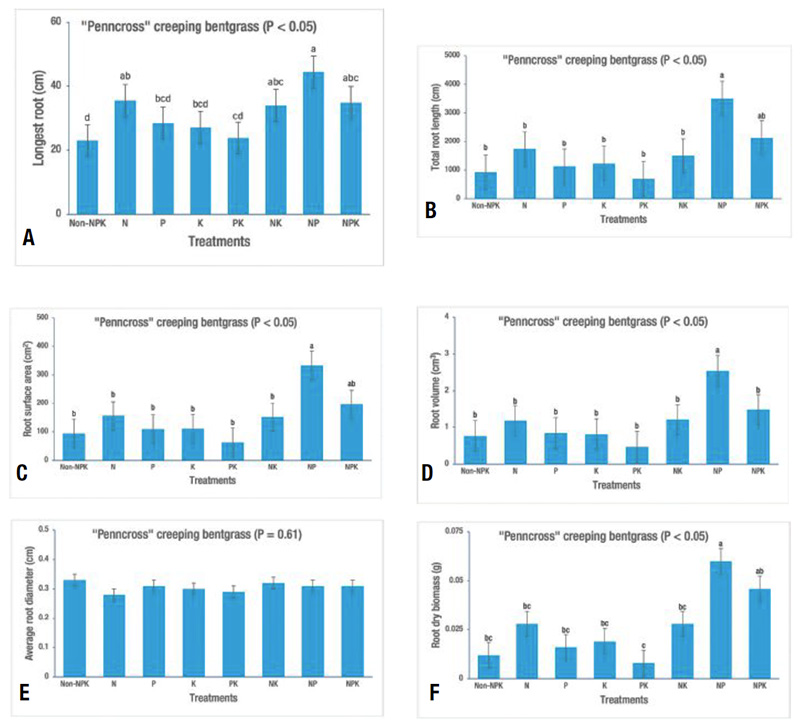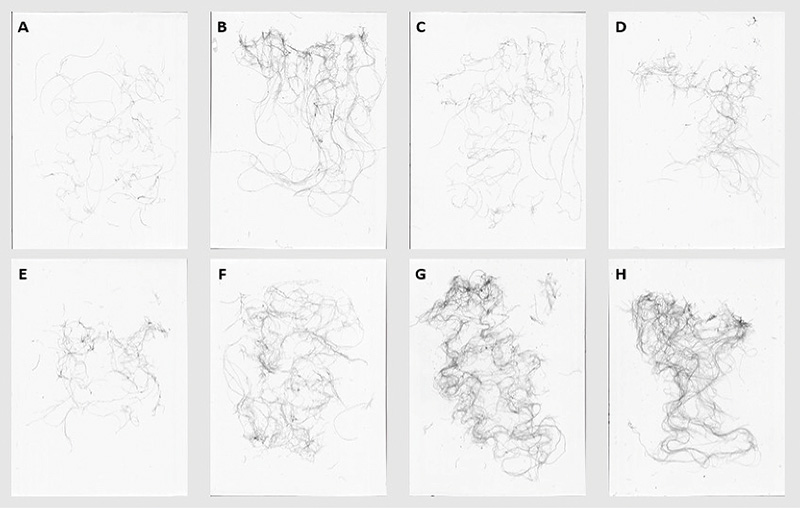
Figure 1. Experimental setup with the tubes arranged at a 45-degree angle to encourage vertical growth of turfgrass roots. Photo by Nirmal Timilsina
A well-balanced fertilizer program supports strong root development and helps turfgrass grow evenly and establish more quickly. The three main nutrients essential for healthy turfgrass are nitrogen (N), phosphorus (P) and potassium (K). Among these, nitrogen is often the most limiting and plays a major role in plant growth, photosynthesis and maintaining the green color of turfgrass. Lack of N can cause yellowing leaves, stunted growth and fewer shoots (5). Phosphorus is also important, especially for root development, and its deficiency can hinder both root and shoot growth in plants (18). Potassium helps turfgrass tolerate stress and resist disease, but too much of it may increase certain turf diseases, like Microdochium patch and gray snow mold (1, 15). Previous research shows that applying N, P and K together can boost turfgrass height, color and growth during establishment (12). However, there's less information on how these nutrients affect turfgrass root structure in detail.
Healthy roots are crucial for absorbing water and nutrients and for helping the plant handle heat and drought (7). Root features like depth, total length, surface area and thickness are shaped by soil conditions and fertilizer levels (14). Balanced nutrition tends to support deeper, more branched root systems, while too much or too little can disrupt root development (10). This study explored how different levels of N, P and K affect the root traits of creeping bentgrass.

Table 1. Chemical properties of the soil used in the experiment. OM = organic matter, CEC = cation exchange capacity, N = nitrogen, P = phosphorus, K = potassium, Ca = calcium, Mg = magnesium, Na = sodium. Soil pH, OM, CEC and nutrient availability were analyzed using the Mehlich III extraction method at the Water's agricultural laboratory (Warsaw, N.C.).
Materials and methods
Growth conditions
Two greenhouse experiments were carried out back to back at North Carolina State University in Raleigh. The first ran from March 3 to May 31, 2023, and the second from March 23 to June 15, 2023. In both, Penncross creeping bentgrass seeds were planted at 43.5 pounds per acre (48.8 kilograms per hectare) in clear acrylic tubes (1.5 inches wide, 24 inches long/3.8 centimeters wide, 61 centimeters long) filled with sand that met USGA putting green standards. The tubes were set at a 45-degree angle to encourage natural root growth (2) (Figure 1). Small holes at the bottom were created to allow for drainage, and each tube served as an individual experimental unit.
Tubes were irrigated four times daily using a gentle spray to keep soil moisture consistent without causing waterlogging. Daytime temperatures averaged 76 F (24.4 C), and nighttime temperatures averaged 70 F (21.1 C) throughout the study. Soil chemical properties were analyzed (Table 1) and included pH, organic matter, cation exchange capacity and nutrient levels using the Mehlich III method.
Experimental design
In each experiment, tubes were randomly assigned to one of eight fertilizer treatments: no fertilizer (control), N, P, K, PK, NK, NP and NPK combinations (Table 2). Nutrients were applied as liquid forms using urea, triple superphosphate and muriate of potash. Each treatment had three replications and was arranged in a completely randomized design. Fertilizer was applied daily on weekdays in a small amount of water using a pipette, starting from the day of seeding. Turfgrass shoots were trimmed to 3 inches (7.6 centimeters) throughout the study. Clippings were collected, dried and weighed to measure shoot growth.

Table 2. Total fertilizers applied per treatment during each experimental run. N = nitrogen, P = phosphorus, K = potassium.
Data collection
Turfgrass was harvested when any plant’s roots reached the bottom of the tube, which was after 89 days in the first experiment and 84 days in the second experiment. Roots were washed clean of sand, and the longest root was measured. Other root traits, including total length, surface area, volume and average diameter, were measured using WinRHIZO image analysis software. Shoots and roots were then dried at 140 F (60 C) for at least 48 hours and weighed to assess biomass.
Statistical analysis
All data were analyzed using a linear mixed-effects model in R (version 2024.04.2). Fertilizer treatment and its interaction with the experimental run were set as fixed effects, while the experimental run was treated as a random effect. Response variables included root and shoot dry mass, root length, surface area, volume, diameter and longest root. Data were transformed as needed to meet statistical assumptions. Where there were no significant interactions between runs and treatments, data were pooled across experiments. Mean differences were tested using Fisher’s LSD at a 5% significance level (3).

Figure 2. Effect of N, P and K fertilizers application on root characteristics of Penncross creeping bentgrass: A) longest root, B) total root length, C) root surface area, D) root volume, E) root diameter and F) root dry biomass. Data are means ± SE. Bars with different letters indicate the values are significantly different (P < 0.05) based on Fisher's LSD test. N = nitrogen, P = phosphorus and K = potassium. Nutrients were applied as liquid forms using urea, triple superphosphate and muriate of potash at the rate of 1.95 kilograms per hectare per day in 5 milliliters water.
Results and discussion
No significant interactions were found between treatment and experimental run; therefore, data from both runs were combined for analysis (data not shown). Fertilizer treatments significantly affected all root characteristics of creeping bentgrass, except average root diameter and shoot dry biomass (Figures 2 and 3).
The NP treatment produced the longest roots and significantly increased total root length, root surface area, root volume and root dry biomass, when compared to the NPK treatment. These findings highlighted the importance of N and P in promoting root development during establishment. Similar trends have been observed in other species. For instance, Razaq et al. (11) found enhanced root traits in Acer mono seedlings under combined N and P fertilization.
Potassium had a negligible effect on root traits. This aligned with findings by Woods et al. (16), which reported that excessive K did not enhance creeping bentgrass growth. Soil analysis (Table 1) showed that K existed in the sand medium which might already meet the creeping bentgrass establishment requirement, suggesting that added K was not limiting. Thus, balanced soil nutrients, especially N and P, were critical for optimal root development, and any deficiencies may hinder early root growth.

Figure 3. Creeping bentgrass root images obtained from WinRHIZO scan, where the grass is fertilized with different combinations of fertilizer including: A) non-NPK, B) Nitrogen (N), C) Phosphorus (P), D) Potassium (K), E) PK, F) NK, G) NP, H) NPK. Nutrients were applied as liquid forms using urea, triple superphosphate and muriate of potash at the rate of 1.95 kilograms per hectare per day in 5 milliliters water.
Although some root traits responded strongly to fertilization, shoot dry biomass and root-shoot ratio were not significantly different among treatments (Figure 4). This indicated that fertilizer impacted root development more than shoot growth during establishment.
However, the correlation between shoot dry biomass and root traits varied by treatment (Table 3). For example, shoot biomass was strongly correlated with total root length and root dry biomass in the non-NPK, P, NK and NPK treatments, but not in the NP, K or N-only treatments. This treatment-specific relationship reflects the complex dynamics of root-shoot interactions under varying nutrient conditions, as also noted in studies on wheat and turfgrass (4, 13).
Numerous articles have documented root response to N, P and K fertilization using root dry biomass in grasses (6, 8, 17). These findings underscored the limitations of relying solely on shoot measurements to infer below-ground growth during early turfgrass establishment. Moreover, the combined use of WinRHIZO image analysis and conventional dry mass measurements provided consistent results, validating both methods for evaluating root traits.
Similar to prior work in turfgrass and forage systems (6, 8, 9, 17), this study demonstrated that NP fertilization consistently led to the strongest root development, whether assessed via detailed morphological metrics or total dry mass. The results also emphasized the critical role of balanced N and P fertilization for promoting root growth in creeping bentgrass during establishment. While shoot responses were relatively stable across treatments, root traits were highly responsive, highlighting the need to tailor early nutrient management to enhance below-ground development of turfgrass.

Figure 4. Effect of N, P and K fertilizers application on Penncross creeping bentgrass: A. shoot dry biomass; B. Root-shoot ratio. Data are means ± SE. N = nitrogen, P = phosphorus and K = potassium. Nutrients were applied as liquid forms using urea, triple superphosphate and muriate of potash at the rate of 1.95 kilograms per hectare per day in 5 milliliters water.
The research says
- This study demonstrated that NP fertilization consistently led to the strongest root development, whether assessed via detailed morphological metrics or total dry mass.
- The results also emphasized the critical role of balanced N and P fertilization for promoting root growth in creeping bentgrass during establishment.
- While shoot responses were relatively stable across treatments, root traits were highly responsive, highlighting the need to tailor early nutrient management to enhance below-ground development of turfgrass.
Literature cited
- Bier, P.V., M. Persche, P. Koch and D.J. Soldat. 2018. A long term evaluation of differential potassium fertilization of a creeping bentgrass putting green. Plant and Soil 431:303-316 (https://doi.org/10.1007/s11104-018-3765-8).
- Brosnan, J., B. Horvath, M. Elmore, G. Breeden and J. Sorochan. 2010. Greenhouse investigation of strobilurin fungicide applications on creeping bentgrass root characteristics under two irrigation regimes. Crop science 50(6):2605-2612 (https://doi.org/10.2135/cropsci2010.02.0088).
- De Mendiburu, F., and R. Simon. 2015. Agricolae — Ten years of an open source statistical tool for experiments in breeding, agriculture and biology. PeerJ PrePrints 3:e1404v1 (https://doi.org/10.7287/peerj.preprints.1404v1).
- Dziamski, A., Z. Stypczyńska and G. Żurek. 2012. Estimation of root and shoot growth of selected grass species on the basis of seedling characterization. Plant Breeding and Seed Science 65:3-14 (https://ojs.ihar.edu.pl/index.php/pbss/article/view/327).
- Fry, J., and B. Huang. 2004. Applied turfgrass science and physiology.
- Garten Jr., C. T., D.J. Brice, H.F. Castro, R.L. Graham, M.A. Mayes, J.R. Phillips, W.M. Post III, C.W. Schadt, S.D. Wullschleger and D.D. Tyler. 2011. Response of ‘Alamo’ switchgrass tissue chemistry and biomass to nitrogen fertilization in West Tennessee, USA. Agriculture, Ecosystems & Environment 140(1-2):289-297 (https://doi.org/10.1016/j.agee.2010.12.016).
- Huang, B. 2008. Mechanisms and strategies for improving drought resistance in turfgrass. Acta Horticulturae 783:221 (https://doi.org/10.17660/ActaHortic.2008.783.22).
- Ihtisham, M., S. Liu, M.O. Shahid, N. Khan, B. Lv, M. Sarraf, S. Ali, L. Chen, Y. Liu and Q. Chen. 2020. The optimized N, P and K fertilization for bermudagrass integrated turf performance during the establishment and its importance for the sustainable management of urban green spaces. Sustainability 12(24):10294 (https://doi.org/10.3390/su122410294).
- Kibet, L.C., H. Blanco-Canqui, R.B. Mitchell and W.H. Schacht. 2016. Root biomass and soil carbon response to growing perennial grasses for bioenergy. Energy, Sustainability and Society 6:1-8 (https://doi.org/10.1186/s13705-015-0065-5).
- Leuschner, C., S. Gebel and L. Rose. 2013. Root trait responses of six temperate grassland species to intensive mowing and NPK fertilisation: A field study in a temperate grassland. Plant and Soil 373:687-698 (https://doi.org/10.1007/s11104-013-1836-4).
- Razaq, M., P. Zhang, H.-I. Shen and Salahuddin. 2017. Influence of nitrogen and phosphorous on the growth and root morphology of Acer mono. Plos One 12(2):e0171321 (https://doi.org/10.1371/journal.pone.0171321).
- Rodriguez, I.R., G.L. Miller and L. McCarty. 2002. Bermudagrass establishment on high sand-content soils using various NPK ratios. HortScience 37(1):208-209 (https://doi.org/10.21273/HORTSCI.37.1.208).
- Tolley, S., and M. Mohammadi. 2020. Variation in root and shoot growth in response to reduced nitrogen. Plants 9(2):144 (https://doi.org/10.3390/plants9020144).
- Wang, Y., K. Thorup-Kristensen, L.S. Jensen and J. Magid. 2016. Vigorous root growth is a better indicator of early nutrient uptake than root hair traits in spring wheat grown under low fertility. Frontiers in Plant Science 7:865 (https://doi.org/10.3389/fpls.2016.00865).
- Woods, M.S., Q.M. Ketterings, F.S. Rossi and A.M. Petrovic. 2006. Potassium availability indices and turfgrass performance in a calcareous sand putting green. Crop Science 46(1):381-389 (https://doi.org/10.2135/cropsci2005.0218).
- Woods, M.S., L.J. Stowell and W.D. Gelernter. 2016. Minimum soil nutrient guidelines for turfgrass developed from Mehlich 3 soil test results. PeerJ Preprints 4:e2144v1 (https://doi.org/10.7287/peerj.preprints.2144v1).
- Xu, Q., and B. Huang. 2006. Seasonal changes in root metabolic activity and nitrogen uptake for two cultivars of creeping bentgrass. HortScience 41(3):822-826 (https://doi.org/10.21273/HORTSCI.41.3.822).
- Zhu, Q., M. Ozores-Hampton, Y. Li, K. Morgan, G. Liu and R.S. Mylavarapu. 2017. Effect of phosphorus rates on growth, yield and postharvest quality of tomato in a calcareous soil. HortScience 52(10):1406-1412 (https://doi.org/10.21273/HORTSCI12192-17).
Nirmal Timilsina is a graduate student in Qiyu Zhou’s lab in the Crop and Soil Sciences (CSS) Department; Emma Simpson is a graduate student who studied in the Plant Physiology Lab in CSS; and Qiyu Zhou (qzhou9@ncsu.edu) is an assistant professor of turfgrass management in CSS, all at North Carolina State University, Raleigh.